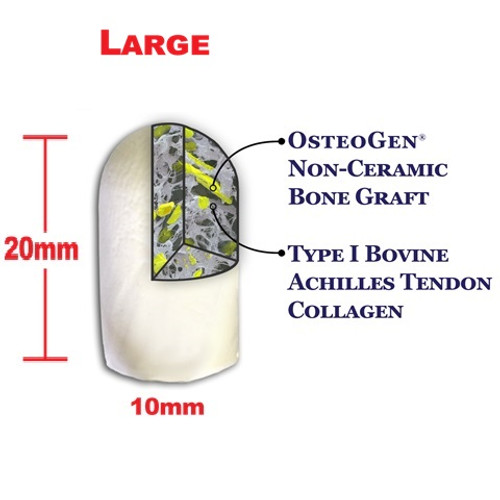- A slim-sized dental bone graft product used for socket preservation and ridge maintenance after tooth extraction
- It is a combination of a collagen plug and a synthetic bone graft material that promotes new bone growth
Purpose:
- It is primarily used for socket preservation following an atraumatic tooth extraction, especially when all socket walls are intact
- The plug provides a scaffold for new bone to form, preventing the jawbone from resorbing
Uses:
- Socket preservation:
- Grafting an extraction site to prevent bone loss and maintain the volume of the alveolar ridge
- Implant site development:
- Growing bone in preparation for a future dental implant, which is typically placed after 6 months
- Ridge augmentation:
- Restoring the height and/or width of the jawbone ridge
- Sinus lifts:
- Grafting material into the sinus cavity to allow for implant placement in the upper jaw
- Grafting around immediate implants:
- Filling gaps between a newly placed implant and the socket walls
Features:
- Materials:
- The plug consists of bioactive, resorbable calcium apatite crystals combined with Type I bovine Achilles tendon collagen
- This composite structure mimics the organic and inorganic components of natural human bone
- One-step solution:
- Unlike traditional grafting methods that require mixing particulate grafts and using a separate membrane, the OsteoGen plug is an all-in-one product
- The collagen acts as a carrier and wound dressing, simplifying the procedure
- Predictable results:
- The product is clinically proven to help grow sufficient bone volume for future dental implant placement
- After 3 to 6 months, the graft is fully replaced by host bone tissue
- No membrane required:
- In cases where all socket walls are preserved, a separate barrier membrane is not necessary to contain the graft
- Radiographic properties:
- The plug appears radiolucent on the day of placement
- As it is replaced by new bone it becomes radiopaque, confirming successful bone formation
- Easy handling:
- The plug can be easily trimmed and shaped to fit the anatomy of the extraction socket
- It is inserted dry and absorbs blood to stabilize the blood clot
Comparing Mineralized, Demineralized, and Pre-Hydrated Bone Graft Materials
- Choosing the right bone graft material can make all the difference when it comes to predictable bone regeneration and implant success
- Understanding the specific features and clinical applications of mineralized, demineralized, and pre-hydrated allografts will help you select the best option for your patient's needs
- Mineralized Bone Grafts
- Mineralized grafts retain their natural inorganic mineral content—primarily hydroxyapatite—which provides immediate structural support
- Applications:
- Often chosen when you need volume stability and a scaffold that maintains shape over time, such as in major ridge augmentations or sinus lifts
- Benefits:
- Acts as a sturdy framework for new bone in-growth, helping preserve ridge dimensions
- Considerations:
- Mineralized grafts integrate through slow remodeling, as the mineral phase is gradually resorbed and replaced by the patient’s own bone
- Demineralized Bone Grafts
- Demineralized options have undergone an acid treatment to remove the mineral phase, leaving behind an organic collagen matrix rich in bone morphogenetic proteins (BMPs)
- Applications:
- Preferred for cases where stimulating rapid new bone formation is the primary goal, such as socket preservation with thin bony walls or repair of smaller defects
- Benefits:
- The presence of BMPs can enhance osteoinduction, prompting the body to lay down new bone faste
- Considerations:
- Lacks the rigid, space-maintaining qualities of mineralized materials, so pairing with a scaffold or membrane is often recommended to prevent collapse
- Pre-Hydrated Bone Grafts
- Pre-hydrated or “ready-to-use” grafts come packaged already reconstituted with sterile saline or other solutions, eliminating the need for chairside mixing
- Applications:
- Valuable in clinical scenarios demanding efficiency and convenience—think multi-site surgeries or time-sensitive procedures
- Benefits:
- Consistency in handling, improved adaptability to defects right out of the package, and reduced preparation time
- Considerations:
- Available in both mineralized and demineralized forms, so you can match the graft’s structural or inductive properties to the surgical indication
- By understanding these differences, you can better align graft selection with your surgical objectives—whether you need a rigid scaffold, enhanced osteoinduction, or a convenient, ready-to-use format
Contents:
- Slim 6mm x 20mm OsteoGen Plug
- 10 Plugs per box









